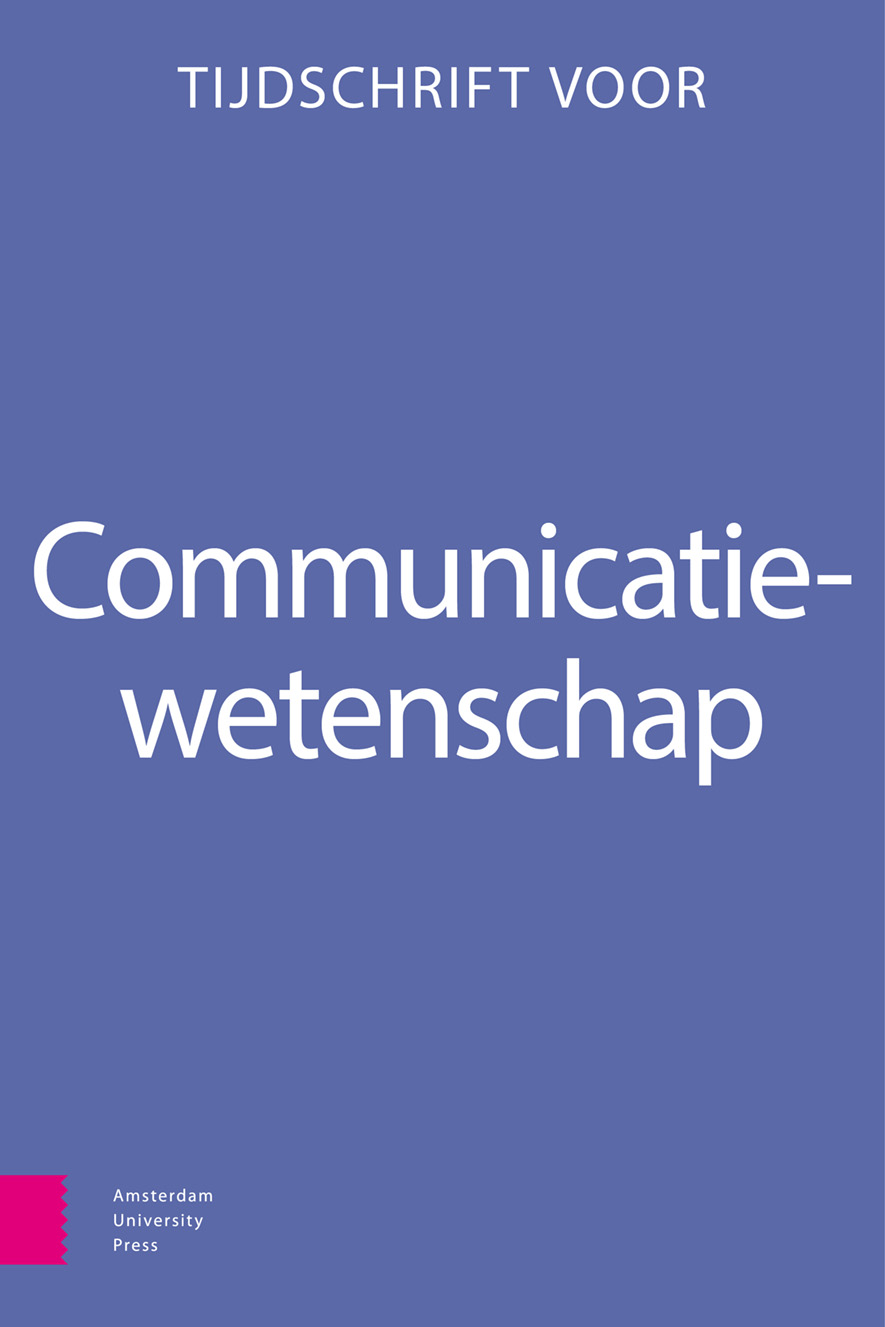- Home
- A-Z Publications
- Tijdschrift voor Communicatiewetenschap
- Previous Issues
- Volume 48, Issue 2, 2020
Tijdschrift voor Communicatiewetenschap - Volume 48, Issue 2, 2020
Volume 48, Issue 2, 2020
-
-
Redactioneel
More LessWetenschappers zijn mensen van de inhoud. Dat geldt met name voor communicatiewetenschappers. Zij gaan de diepte in met het onderzoek dat zij doen. Onderzoek náár de inhoud. Zij bestuderen mediaberichten, communicatie-uitingen of dialogen. Hoe ze geproduceerd, gedistribueerd en geconsumeerd worden. Hoe ze mensen bereiken of in beweging brengen, informeren of interesseren, verblijden of verblinden. Het nummer dat voor u ligt is daar het resultaat van. In drie originele bijdragen worden kritische vragen gesteld, fenomenen beschreven, geduid of in een bredere context geplaatst.
-
-
-
Responsieve diversiteit: een andere kijk op nieuwsdiversiteitGoed functionerende democratieën plaatsen nieuwsdiversiteit centraal. We stellen ter vervanging van reflectieve diversiteit – een proportionele verdeling van opvattingen die voorkomen in de samenleving – responsieve diversiteit voor. Dit concept herpositioneert journalistiek in het spanningsveld tussen nieuwsproductie, waarbij een zo groot mogelijke heterogeniteit wordt nagestreefd, en nieuwsconsumptie, waarbij nieuwsmakers kritisch meedenken met het publiek en het confronteren met afwijkende opvattingen.
More LessAuthors: Hanne Vandenberghe, Leen d’Haenens & Pascal VerhoestResponsive diversity: a new look at news diversityDiversity is one of the key issues in a well-functioning democratic society. However, there are multiple ways to interpret diversity. In this article, we argue that the commonly used interpretation of representative diversity, as reflecting societal diversity, has become obsolete. Therefore, we suggest a renewed approach to news diversity with the notion of responsive diversity. According to this concept, journalists are responsible to incorporate the open diversity standard (i.e., representing all opinions equally in the news content) while at the same time responding to citizens’ concerns by putting information into perspective, and this includes exposure to different viewpoints.
-
-
-
Oude wijn in nieuwe zakken?Politieke microtargeting wordt soms gepresenteerd als een revolutionaire manier van campagnevoeren. In dit artikel beschrijven wij wat microtargeting behelst, plaatsen wij kanttekeningen bij microtargetings veronderstelde nieuwigheid en maken wij een historische vergelijking met microtargeting in het pre-massapartijentijdperk. We concluderen dat microtargeting als idee niet nieuw is, maar dat de technologie die tegenwoordig wordt gebruikt heeft gezorgd voor fundamentele veranderingen.
More LessAuthors: Tom Dobber & Ron de JongOld wine in new bottles? A historical comparison of microtargeting in the NetherlandsPolitical microtargeting is sometimes presented as a revolution in political campaigning. Sending citizens tailored political messages is considered effective, efficient, and modern, especially in the Netherlands. In this article we dive deeper into the concept of microtargeting. We compare modern-day microtargeting and political campaigns in the pre-mass party era, who already tailored political messages to individual citizens as early as in the 1900’s. We describe similarities and differences between the ‘old’ and ‘new’ campaigns to illustrate how, conceptually, both forms of ‘microtargeting’ do not differ that much. Finally, we conclude that while the concept may be similar, the practice does differ. Technology not only enables political parties to reach unparalleled levels of granularity, but also to spread messages on an incomparable scale. Thus, we may speak of old wine in new bottles. But the new bottles may be so dominant that they have changed the old taste of the wine.
-
-
-
Vluchtelingen in beeldDit artikel onderzoekt hoe Vlaamse nieuwsmedia berichten over vluchtelingen in tijden van veel maatschappelijk debat over migratie. De onderzochte televisiezenders VTM en VRT berichten op een evenwichtige manier en creëren over het algemeen geen expliciet ‘wij-zij’-perspectief, ondanks enkele negatieve representatiediscoursen zoals stereotiepe beelden, negatief woordgebruik en het collectiviseren van vluchtelingen. Ook rapporteert openbare omroep VRT meer genuanceerd en uitgebreider dan commerciële zender VTM.
More LessAuthors: Hanne Van Haelter & Stijn JoyeRefugees on screen. A critical discourse analysis of the news discourse about Syrian refugees by the public and commercial broadcaster in FlandersThe civil war in Syria, ongoing since 2011, forced 6.7 million people to flee their country (UNHCR, 2019). Applying a critical discourse analysis, this study investigates the representation of refugees by the public (VRT) and the commercial (VTM) broadcaster in Flanders, focusing on September 2015 and December 2018. Our findings show that Flemish news media do not discursively reproduce the established socio-demographic binary of ‘us’ and ‘them’ as they generally tend to avoid portraying refugees as ‘others’. The public broadcaster reports more on the topic and offers more contextualization, resulting in a more nuanced style of reporting. Nevertheless, there are a few implicit articulations of a negative discourse about refugees as both broadcasters occasionally apply negative nomenclature and use stereotypical imagery.
-
-
-
Boekbespreking
More LessBy Ronald VoornKaren Nelson-Field is oprichter en executive director van Amplified Intelligence alsmede hoogleraar Media Innovation aan de Universiteit van Adelaide in Australië. In haar vorige boek uit 2013 besprak zij, op basis van onderzoek, wat fabel of feit was met betrekking tot viral marketing.
-
-
-
Summaries
More LessDiversity is one of the key issues in a well-functioning democratic society. However, there are multiple ways to interpret diversity. In this article, we argue that the commonly used interpretation of representative diversity, as reflecting societal diversity, has become obsolete. Therefore, we suggest a renewed approach to news diversity with the notion of responsive diversity. According to this concept, journalists are responsible to incorporate the open diversity standard (i.e., representing all opinions equally in the news content) while at the same time responding to citizens’ concerns by putting information into perspective, and this includes exposure to different viewpoints.
-
Volumes & issues
-
Volume 52 (2024)
-
Volume 51 (2023)
-
Volume 50 (2022)
-
Volume 49 (2021)
-
Volume 48 (2020)
-
Volume 47 (2019)
-
Volume 46 (2018)
-
Volume 45 (2017)
-
Volume 44 (2016)
-
Volume 43 (2015)
-
Volume 42 (2014)
-
Volume 41 (2013)
-
Volume 40 (2012)
-
Volume 39 (2011)
-
Volume 38 (2010)
-
Volume 37 (2009)
-
Volume 36 (2008)
-
Volume 35 (2007)
-
Volume 34 (2006)
-
Volume 33 (2005)
Most Read This Month


